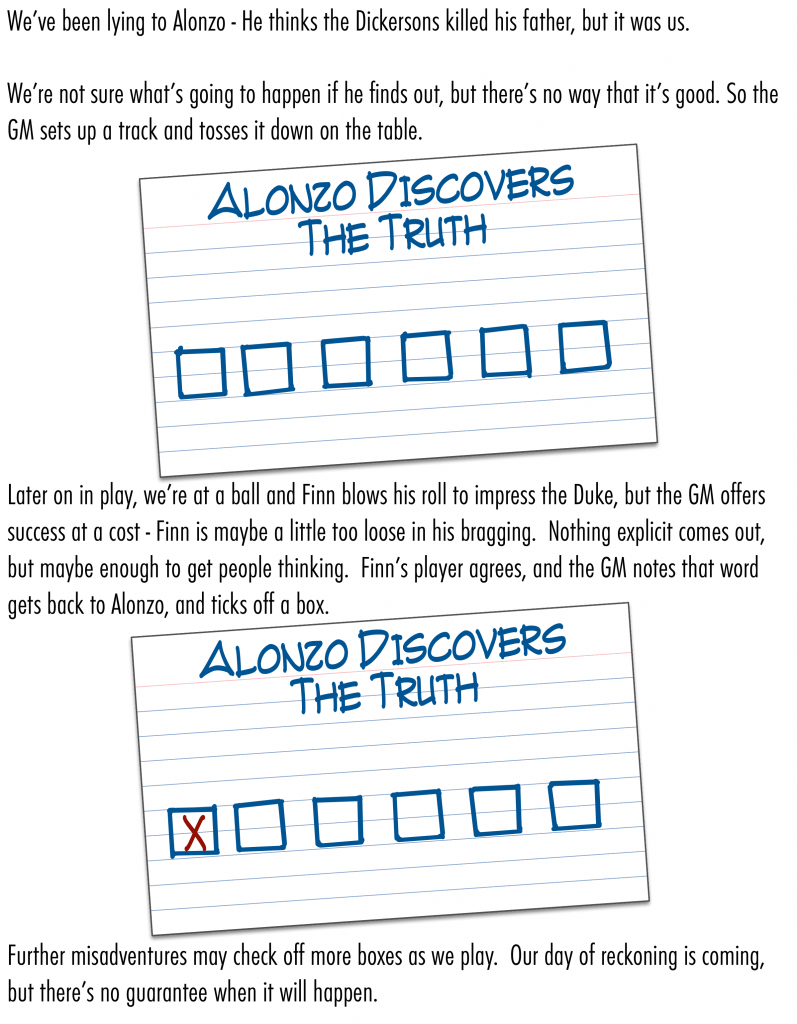 One of the things I’ve stumbled with a little in Blades in the Dark is that injuries are not a lot of fun. I get that it’s necessary for them to feel like they hurt for the game to feel gritty, but the fact that recovery is so slow is a real hindrance on play, specifically because it burns so many downtime actions. Now, I’m not sure how this is at other tables, but my players (and I) love our downtime actions. They are sweet, sweet candy. So the penalty to them seems onerous.
One of the things I’ve stumbled with a little in Blades in the Dark is that injuries are not a lot of fun. I get that it’s necessary for them to feel like they hurt for the game to feel gritty, but the fact that recovery is so slow is a real hindrance on play, specifically because it burns so many downtime actions. Now, I’m not sure how this is at other tables, but my players (and I) love our downtime actions. They are sweet, sweet candy. So the penalty to them seems onerous.
This has also made me – as a GM – more hesitant to inflict harm as a consequence because I knew it was not a fun option. That’s not a great place to be.
Thankfully, a conversation on Google Plus got me thinking about becoming more flexible in removing harm, and in a subsequent session, our Cutter got gassed and took a severe consequence, but it cleared up once he had time to walk it off. This felt SO much more natural and comfortable that I realized I needed to really rethink how I used harm in blades.
One thing that clearly jumped out is that by becoming more liberal in how harm gets cleared, I can also be more flexible in my definition of harm. Harm has always been a fuzzy thing, but I have never gone fully narrative with it. That is, because the way to clear harm was medical treatment, I was only comfortable using harm for things that could be cleared with medical treatment.
But if you adopt a flexible stance on harm removal, that also allows for a flexible stance on what constitutes harm. Emotional trauma? Reputation? Getting covered from head to toe in goat crap? If I treat all these things as Harm then I have a whole slew of new tools in my toolbox, and since the mechanical impacts of harm generalize well, they slot in seamlessly.
As a bonus, this underscores the fact that being taken out by harm does not kill a character. Now, when they are taken out by harm, it does not need to be an act of death defiance. It could just as easily be that it all became too much, or that they needed to go underground. I like this a lot.
And the funny thing is that while I got into this because I wanted the option to have more easily-clearable harm, this flexibility does not oblige me to that. Non-physical harm may require just as much (or more) effort to clear than regular harm. The difference is that for social and emotional harm, those means will often be more interesting than visiting the doctor. Social harm in particular can obviously be mapped to clocks, but it can also be addressed with a score. I kind of love that.
Now, I’m am totally good simply knowing this, but if you need some guidelines to mechanize this a bit, then let’s lean into the BitD ethos and say it’s more than one thing. 🙂
Harm Duration Guidelines
- Harm has Severity and Duration, both from 1-4
- Severity is the current level of harm. exactly as described in the rules.
- Duration reflects how hard it is to clear/reduce
- 1 (Momentary): Can be cleared with an easy action that requires no dice, like cleaning up, grabbing a meal or otherwise taking the time to clear it.
- 2 (Temporary): Can be cleared with a single appropriate downtime action, or as a result of a more difficult roll or time intensive activity (like getting a full night’s sleep).
- 3 (Persistent): Can be reduced with a single appropriate downtime action. This is the current default model, with the “appropriate action” being the medical roll. Other actions may require smaller or larger clocks, or no clock at all.
- 4 (Lingering): Cannot be easily reduced or cleared. Will usually require some sort of action to determine how to clear it, or to remove the thing that’s keeping it from being cleared.
- While the default Duration in Blades is 3, it can obviously be slid up and down as a result of the fiction. The GM should communicate duration along with severity when informing players of consequence.
- The expectation is that duration should flow very logically form the fiction. For example, getting drunk would be temporary harm, of a severity that rather depends on how drunk.
- The expectation is that duration also gives the GM a freer hand with severity, since there are now two ways to show how serious something is. Low severity but high duration tells a different story than high severity and low duration.
- What harm may be used to reflect is entirely up to the GM

